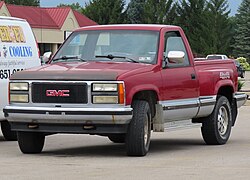| Fourth generation (GMT400) | |
|---|---|
 1995–1996 Chevrolet K1500 Silverado extended cab with Fleetside 6.5' bed | |
| Overview | |
| Manufacturer | Chevrolet (GM) GMC Truck (GM) |
| Also called | GMC Sierra Chevrolet Silverado (1999–2000 Argentina and Brazil) Chevrolet Cheyenne (Mexico) |
| Production | December 8, 1986 – 2000 (US, standard and extended cab) October 1991 – 2000 (US, four-door) 1990–2002 (US, C3500HD) 1991–2001 (Mexico and Venezuela) 1997–2001 (Argentina and Brazil) |
| Model years | 1988–2000 (standard/extended cab) 1992–2000 (crew cab) 1991–2002 (C3500HD chassis cab) |
| Assembly | Arlington, Texas (Arlington Assembly) (1998–2000) Roanoke, Indiana (Fort Wayne Assembly) Flint, Michigan (Flint Truck Assembly) (1995–2000) Janesville, Wisconsin (Janesville Assembly) Pontiac, Michigan (GMC Truck & Coach Plant 6) Oshawa, Ontario (Oshawa Truck Assembly) Toluca, Mexico (Toluca Assembly) |
| Designer | Donald Wood (1983) [1] [2] |
| Body and chassis | |
| Class | Full-size pickup truck |
| Body style | 2-door pickup truck 2/3-door extended cab pickup truck 4-door crew cab pickup truck 2-door/4-door chassis cab |
| Layout | Front-engine, rear-wheel drive Front-engine, four-wheel drive |
| Platform | GM GMT400 platform |
| Chassis | Body-on-frame |
| Related | Chevrolet K5 Blazer/Chevrolet Tahoe Chevrolet/GMC Suburban GMC Yukon Cadillac Escalade |
| Powertrain | |
| Engine | 250 cu in (4.1 L) I6 (Argentinian-made versions only) 262 cu in (4.3 L) V6 292 cu in (4.8 L) I6 (Mexico only) 305 cu in (5.0 L) V8 350 cu in (5.7 L) V8 454 cu in (7.4 L) V8 496 cu in (8.1 L) V8 (2001–02 C3500HD only) 4.2 L MWM Sprint 6.07T I6 diesel (Argentina and Brazil) 379 cu in (6.2 L) diesel V8 395 cu in 6.5 L turbo diesel V8 |
| Transmission | 3-speed THM-400 automatic 4-speed 700R4 automatic 4-speed 4L60 automatic 4-speed 4L60-E automatic 4-speed 4L80-E automatic 4-speed SM465 manual 5-speed NV3500 manual 5-speed NV4500 manual 5-speed HM290 manual 5-speed 5LM60 manual |
| Dimensions | |
| Wheelbase | 117.5 in (2,984 mm) (regular cab/6.5' bed) 131.5 in (3,340 mm) (regular cab/8' bed) 141.5 in (3,594 mm) (extended cab/6.5' bed) 155.5 in (3,950 mm) (extended cab/8' bed) 154.5 in (3,924 mm) (crew cab/6.5' bed) 168.5 in (4,280 mm) (crew cab/8' bed) |
| Length | 194.5 in (4,940 mm) (regular cab/6.5' bed) 213.1 in (5,413 mm) (regular cab/8' bed) 218.5 in (5,550 mm) (extended cab/6.5' bed) 231.5 in (5,880 mm) (crew cab/6.5' bed) 237.4 in (6,030 mm) (extended cab/8' bed) 250.1 in (6,353 mm) (crew cab/8' bed) |
| Width | 76.8 in (1,951 mm) (Fleetside) 77.1 in (1,958 mm) (Sportside) 94.3 in (2,395 mm) (DRW) |
| Height | 73.2 in (1,859 mm) 72.6 in (1,844 mm) |
| Chronology | |
| Predecessor | Chevrolet C/K (third generation) (Rounded Line) |
| Successor | Chevrolet Silverado (first generation) (GMT800) |
The fourth generation of the C/K series is a range of trucks that was manufactured by General Motors. Marketed by the Chevrolet and GMC brands from the 1988 to the 2002 model years, this is the final generation of the C/K model line. In a branding change, GMC adopted the GMC Sierra nameplate for all its full-size pickup trucks, leaving the C/K nomenclature exclusive to Chevrolet.
Contents
- Development
- R/V series (1987–1991)
- Model history
- 1988–1994
- 1995–1998
- 1999–2002
- Model overview
- Chassis
- Powertrain details
- Body design
- Interior
- Trim
- Variants
- Medium-duty trucks
- Sport-utility vehicles
- Pickup trucks
- Export and foreign production
- Australia and New Zealand
- Brazil
- Motorsport
- References
- External links
Internally codenamed the GMT400 platform, GM did not give the model line a word moniker (e.g., "Rounded-Line series" for its predecessor). After its production, the model line would informally become known by the public as the "OBS" (Old Body Style), in reference to its GMT800 successor. [3] In starting a different tradition, the model line overlapped production with both its predecessor and successor; the model line again shared body commonality with GM medium-duty commercial trucks.
Over nearly a 14-year production run, the fourth-generation C/K was assembled by GM in multiple facilities in the United States, Canada, and Mexico. [4] [5] After the 2000 model year, the fourth-generation C/K was discontinued and was replaced by the GMT800 platform (introduced for 1999); the C3500HD heavy-duty chassis cab model remained in production through 2002. In line with the GMC Sierra, Chevrolet subsequently adopted a singular Chevrolet Silverado nameplate for its full-size truck line (which remains in use).

























